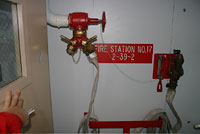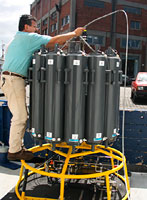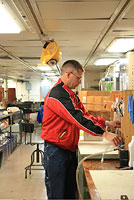

 | |||||||||||||||
|
|
Journals 2008/2009Jeff Lawrence
December 5, 2008 The R/V ROGER REVELLE left port from Montevideo, Uruguay yesterday afternoon at 4:00 pm local time or 18:00 GMT. The time is four hours ahead of (CDT) Central Daylight Time. Before departing, the science crew, which includes 33 members from all around the world met in the ship's library to coordinate the events and schedule for the cruise. Many lab experiments will be going on simultaneously and efforts are being made to ensure that there are enough carboys (water samples from the CTD) for each scientific measurement that will be occurring along the way.
We also had a safety meeting. Safety of the scientist and crew is of foremost importance, followed by the safety of the ship, and then of course the science. If someone gets seriously injured it could jeopardize the entire study. We also had a safety drill, which included man overboard, fire suppression, and abandoned ship. Each person aboard has a specific place and task to perform when there is a drill or actual emergency. You must wear closed toed shoes for safety while working onboard, dress appropriately in case of emergencies, and don a life jacket and possibly an exposure suit if the weather warrants it.
Today we will sail to our first deployment or staging area in which the CTD will be deployed to gather water samples so scientist can extract a sample amount they each need to conduct their specific lab. An instrument called a CTD is an important instrument used in oceanographic science allowing scientist to gather samples of ocean water up and down the water column. The CTD is pictured below and designed to gather water samples, each canister will open at a different depth to gather samples for various experiments aboard the . This will give scientist a better understanding of water density, pH, salinity, and the variety of biological life forms that may be present at that depth.
Final preparations for stations in the main lab are being completed. The scientist will begin collecting water samples today using the CTD to gather water samples. The samples will then be distributed throughout the ship for analysis. I am in the main lab securing a few valves for use in the fluorometer, which will help determine the size and amount of biological creatures that are living within the water sample at a particular depth.
Questions of the Day:
Reminder: You can find the current ship location and much more data at: |
||||||||||||||



